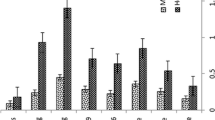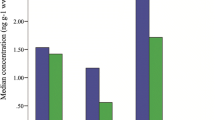Abstract
Individual congeners of polychlorinated biphenyls (PCBs), including the highly toxic non-ortho coplanar 3,3′,4,4′-tetrachlorobiphenyl (IUPAC No. 77), 3,3′,4,4′,5-pentachlorobiphenyl (IUPAC No. 126), and 3,3′,4,4′,5,5′-hexachlorobiphenyl (IUPAC No. 169), and their mono- and di-ortho analogs, have been identified and quantified in the blubber, liver, and muscles of three female common porpoise Phocoena phocoena collected from the Puck Bay (inner Gulf of Gdańsk, Poland) in 1989–1990, to elucidate actual concentrations and toxic potential. The total 2,3,7,8-tetrachlorodibenzo-p-dioxin toxic equivalent for 13 coplanar PCBs in blubber was 1,500±470 pg/g wet wt. 2,3′,4,4′,5-Pentachlorobiphenyl (IUPAC No. 118) was the most contributing individual and occupied between 57 and 67% in total toxic equivalent of coplanar PCBs in blubber, while 2,2′,4,4′,5,5′-hexachlorobiphenyl (IUPAC No. 153), 2,3,3′,4,4′-pentachlorobiphenyl (IUPAC No. 105) and 2,2′,3,4,4′,5′-hexachlorobiphenyl (IUPAC No. 138) comprised between 9.5–14, 7.6–11.5, and 7.2–11.0%, respectively (totally 82–95%), and 2,3,3′,4,4′,5-hexachlorobiphenyl (IUPAC No. 156) was absent. A potentially most toxic non-ortho PCB members such as 3,3′,4,4′,5-pentachlorobiphenyl, 3,3′,4,4′,5,5′-hexachlorobiphenyl and 3,3′,4,4′-tetrachlorobiphenyl were only minor contributors, altogether occupying between 1.0 and 14.5% in total TEQ of coplanar PCBs. Concentrations of total PCBs in lipids of the blubber ranged from 26 to 47 μg/g and were comparable or lower than reported earlier for common porpoises from the Baltic Sea, North Sea, and North Atlantic by other authors.
Similar content being viewed by others
References
Andersson O, Linder C-E, Olsson M, Reutergardh L, Uvemo U-B, Wideqvist U (1988) Spatial differences and temporal trends of organochlorine compounds in biota from the northwestern hemisphere. Arch Environ Contam Toxicol 17:755–765
Aulerich RJ, Ringer RK (1977) Current status of PCB toxicity to mink, and effects on their reproduction. Arch Environ Contam Toxicol 6:279–287
Beck H, Breuer EM, Drob A, Mathar W (1990) Residues of PCDDs, PCDFs, PCBs and other organochlorine compounds in harbour seals and harbour porpoise. Chemosphere 20:1027–1034
Duinker JC, Hillebrand MTJ, Zeinstra T, Boon JP (1989) Individual chlorinated biphenyls and pesticides in tissues of some cetacean species from the North Sea and the Atlantic Ocean; tissue distribution and biotransformation. Aquat Mamm 15:95–124
Falandysz J, Tanabe S, Tatsukawa R (1993a) Most toxic and highly bioaccumulative PCB congeners in cod-liver oil of Baltic origin processed in Poland during the 1970s and 1980s, their TEQ-values and possible intake. Sci Total Environ (in press)
Falandysz J, Yamashita N, Tanabe S, Tatsukawa R, Rucińska L, Mizera T, Jakuczun B (1993b) Congener-specific analysis of PCBs in white-tailed sea eagles Haliaeetus albicilla collected in Poland. Arch Environ Contam Toxicol 26:13–22
Gaskin DE, Frank R, Holdrinet M (1983) Polychlorinated biphenyls in harbour porpoises, Phocoena phocoena (L.) from the Bay of Fundy, Canada, and the adjacent waters, with some information on chlordane and hexachlorobenzene levels. Arch Environ Contam Toxicol 12:211–219
Helle E, Olsson M, Jensen S (1976) PCB levels correlated with pathological changes in seal uteri. Ambio 5:261–263
Jensen S, Kihlstrom JE, Olsson M, Lundberg C, Orberg J (1977) Effects of PCB and DDT on mink (Mustela vison) during the reproductive season. Ambio 6:239–242
Kannan K, Falandysz J, Tanabe S, Tatsukawa R (1993) Persistent organochlorines in harbour porpoises from Puck Bay, Poland. Mar Pollut Bull 26:162–165
Kinloch D, Kuhnlein H, Muir DCG (1992) Inuit foods and diet: a preliminary assessment of benefits and risk. Sci Total Environ 122:247–278
Morris RW, Law RJ, Allchin CR, Kelly CA, Fileman CF (1989) Metals and organochlorines in dolphins and porpoises of Cardigan Bay, West Wales, Mar Pollut Bull 20:512–523
Newton I, Wyllie I, Asher A (1992) Long-term trends in pollutant levels in predatory birds, 1991–1992 Report. Institute of Terrestrial Ecology, Natural Environment Research Council, UK, pp 46–49
Reijnders PJH (1986) Reproductive failure in common seals feeding on fish from polluted coastal waters. Nature 324:456–457
Safe S (1990) Polychlorinated biphenyls (PCBs), dibenzo-p-dioxins (PCDDs), dibenzofurans (PCDFs), and related compounds: Environmental and mechanistic considerations which support the development of toxic equivalency factors. CRC Crit Rev Toxicol 21:51–88
Storr-Hansen E, Spliid H (1993) Coplanar polychlorinated biphenyl congener levels and patterns and the identification of separate populations of harbour seals (Phoca vitulina) in Denmark. Arch Environ Contam Toxicol 24:44–58
Tanabe S, Kannan N, Wakimoto T, Tatsukawa R, Okamoto T, Masuda Y (1989) Isomer-specific determination and toxic evaluation of potentially hazardous coplanar PCBs, dibenzofurans and dioxins in the tissues of “Yusho” PCB poisoning victim and in the causal oil. Toxicol Environ Chem 24:215–231
Tanabe S, Tatsukawa R (1991) Persistent organochlorines in marine mammals. In: Jones KC (ed) Organic contaminants in the environment. Environmental pathways and effects. Elsevier Applied Science, Amsterdam, pp 275–289
Tanabe S, Kannan N, Wakimoto T, Tatsukawa R (1987a) Method for the determination of three toxic coplanar PCBs in environmental samples at parts per trillion levels. Int J Environ Anal Chem 29:199–213
Tanabe S, Tatsukawa R, Phillips DJH (1987b) Mussels as bioindicators of PCB isomers and congeners in green-lipped mussels (Perna viridis) in Hong Kong waters. Environ Pollut 47:41–62
Tanabe S, Watanabe S, Kan H, Tatsukawa R (1988) Capacity and mode of PCB metabolism in small cetaceans. Mar Mamm Sci 4:103–124
Yamashita N, Tanabe S, Ludwig JP, Kurita H, Ludwig ME, Tatsukawa R (1993) Embryonic abnormalities and organochlorine contamination in double-crested cormorants (Phalacrocorax auritus) and caspian terns (Hydroprogne caspia) from the Upper Great Lakes in 1988. Environ Pollut 79:163–173
Author information
Authors and Affiliations
Rights and permissions
About this article
Cite this article
Falandysz, J., Yamashita, N., Tanabe, S. et al. Congener-specific data on polychlorinated biphenyls in tissues of common porpoise from Puck Bay, Baltic Sea. Arch. Environ. Contam. Toxicol. 26, 267–272 (1994). https://doi.org/10.1007/BF00203551
Received:
Revised:
Issue Date:
DOI: https://doi.org/10.1007/BF00203551




